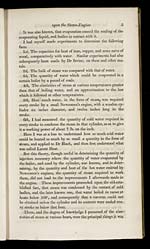James Watt (1736-1819)
History of the origin of Mr Watt's improvements on the steam-engine.
upon the Steam-Engine.
5
It was also known, that evaporation caused the cooling of the
evaporating liquid, and bodies in contact with it.
I had myself made experiments to determine the following
facts.
1st, The capacities for heat of iron, copper, and some sorts of
wood, comparatively with water. Similar experiments had also
subsequently been made by Dr Irvine, on these and other me-
tals.
2d, The bulk of steam was compared with that of water.
3d, The quantity of water which could be evaporated in a
certain boiler by a pound of coals.
4th, The elasticities of steam at various temperatures greater
than that of boiling water, and an approximation to the law
which it followed at other temperatures.
5th, How much water, in the form of steam, was required
every stroke by a small Newcomen’s engine, with a wooden cy-
linder six inches diameter, and twelve inches long in the
stroke.
6th, I had measured the quantity of cold water required in
every stroke to condense the steam in that cylinder, so as to give
it a working power of about 7 lb. on the inch.
Here I was at a loss to understand how so much cold water
could be heated so much by so small a quantity in the form of
steam, and applied to Dr Black, and then first understood what
was called Latent Heat.
But this theory, though useful in determining the quantity of
injection necessary where the quantity of water evaporated by
the boiler, and used by the cylinder, was known, and in deter-
mining, by the quantity and heat of the hot water emitted by
Newcomen’s engines, the quantity of steam required to work
them, did not lead to the improvements I afterwards made in
the engine. These improvements proceeded upon the old-esta-
blished fact, that steam was condensed by the contact of cold
bodies, and the later known one, that water boiled in vacuo at
heats below 100°, and consequently that a vacuum could not
be obtained unless the cylinder and its contents were cooled eve-
ry stroke to below that heat.
These, and the degree of knowledge I possessed of the elas-
ticities of steam at various heats, were the principal things it was


